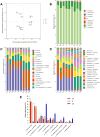Microorganism changes in the gut of Apis mellifera surviving for the long term in Camellia oleifera forests
- PMID: 40575481
- PMCID: PMC12198164
- DOI: 10.3389/fcimb.2025.1608835
Microorganism changes in the gut of Apis mellifera surviving for the long term in Camellia oleifera forests
Abstract
Alpha-galactosides (oligosaccharides) in C. oleifera nectar and pollen cause honey bee larval rot and worker bloats. Honey bee colonies surviving in C. oleifera forests for a long period have low rates of larval rot and worker bloats; however, the mechanism of oligosaccharide metabolism is unclear. In this study, we used metagenomics and metabolomics to investigate the structure and function of the gut flora and the digestion characteristics of oligosaccharides in the gut of A. mellifera foragers (CN group) that had been in the C. oleifera forest for a long period (continuously for 14 years), and those that had not been pollinated with C. oleifera (N group) after 24 h of consumption of C. oleifera honey. The results revealed that the abundance of Gilliamella apicola up to 24.08%, which can metabolize α-galactoside (α-Gal), was significantly higher (P < 0.05) in the gut of foragers in the CN group than in the N group. Additionally, the gut flora of foragers in the CN group carried a significantly higher (P < 0.05) abundance of genes encoding α-galactosidase (Glycoside hydrolase family 4, GH4) than the N group. Similarly, metabolomic results indicated that the three toxic oligosaccharides in C. oleifera honey were lower in the gut of CN group foragers. These results suggest that the gut flora of A. mellifera, which inhabits oil tea forests for long periods of time, changes and adapts to the predominant ecological niche, enhancing the host's ability to metabolize toxic oligosaccharides. This important discovery provides positive guidance for the subsequent directions for breeding of A. mellifera (G. apicola enrichment and GH4 upregulation), specialized in pollinating C. oleifera.
Keywords: GH4; Gilliamella apicola; honey bee; microbial structure; pollinate.
Copyright © 2025 Chen, Li, Yuan, Chen, Xu, Tang and Liu.
Conflict of interest statement
Author DY was employed by the company Hunan Linkeda Agricultural and Forestry Technology Service Co., Ltd. The remaining authors declare that the research was conducted in the absence of any commercial or financial relationships that could be construed as a potential conflict of interest.
Figures





Similar articles
-
Are you my mother? When host genetics and gut microbiota tell different phylogenetic stories in the Africanized honey bee hybrid (Apis mellifera scutellata × sspp.).Microbiol Spectr. 2025 Jul;13(7):e0247524. doi: 10.1128/spectrum.02475-24. Epub 2025 May 28. Microbiol Spectr. 2025. PMID: 40434076 Free PMC article.
-
The use of gut bacteria isolated from Thai honey bees (Apis spp.) to control Nosema ceranae infection in the giant honey bee, Apis dorsata.J Invertebr Pathol. 2025 Sep;212:108397. doi: 10.1016/j.jip.2025.108397. Epub 2025 Jul 7. J Invertebr Pathol. 2025. PMID: 40633721
-
Foraging task specialization in honey bees (Apis mellifera): the contribution of floral rewards to the learning performance of pollen and nectar foragers.J Exp Biol. 2024 Jul 1;227(13):jeb246979. doi: 10.1242/jeb.246979. Epub 2024 Jul 1. J Exp Biol. 2024. PMID: 38873739
-
Sertindole for schizophrenia.Cochrane Database Syst Rev. 2005 Jul 20;2005(3):CD001715. doi: 10.1002/14651858.CD001715.pub2. Cochrane Database Syst Rev. 2005. PMID: 16034864 Free PMC article.
-
Behavioral interventions to reduce risk for sexual transmission of HIV among men who have sex with men.Cochrane Database Syst Rev. 2008 Jul 16;(3):CD001230. doi: 10.1002/14651858.CD001230.pub2. Cochrane Database Syst Rev. 2008. PMID: 18646068
References
-
- Gao C., Yang R., Yuan D. (2018). Structural characteristics of the mature embryo sac of Camellia oleifera . Nord. J. Bot. 36, njb–01673. doi: 10.1111/njb.01673 - DOI
-
- Hayakawa K., Mizutani J., Wada K., Masai T., Yoshihara I., Mitsuoka T. (1990). Effects of soybean oligosaccharides on human faecal flora. Microb. Ecol. Health Dis. 3, 293–303. doi: 10.3109/08910609009140252 - DOI
-
- He W. Y., Li J. H., Yin X. (2019). Domestication and breeding of Apis mellifera ligustica pollinated by Camellia oleifera . Hunan. Forestry. Sci. Tech. 46, 44–48.
MeSH terms
Substances
LinkOut - more resources
Full Text Sources

